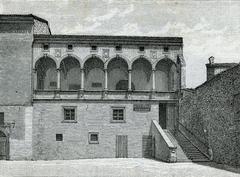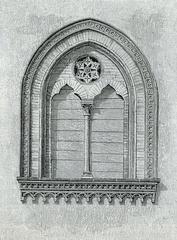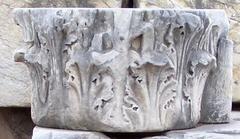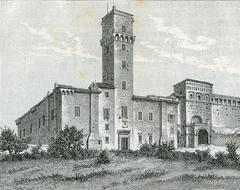
Visiting Palazzo Malatestiano: History, Tickets, and Tips
Date: 01/08/2024
Introduction
Palazzo Malatestiano, a magnificent Renaissance palace located in the heart of Fano near Pesaro, Italy, stands as a testament to the grandeur and cultural richness of the Malatesta family, who were significant patrons of the arts during the Renaissance period. Constructed between 1413 and 1421 by Pandolfo III Malatesta, the palace encapsulates the architectural elegance and historical significance of the early 15th century. Visitors to Palazzo Malatestiano are not only treated to the stunning architectural features that blend classical elements such as columns and arches with Renaissance symmetry and proportion but also to a journey through history, art, and culture (Italy This Way). Today, the palace houses the Museo Archeologico e Pinacoteca, a museum dedicated to archaeology and art, showcasing artifacts from various historical periods and an impressive collection of paintings by renowned artists. This guide provides a comprehensive overview of what to expect when visiting Palazzo Malatestiano, including ticket information, visiting hours, and nearby attractions, ensuring a memorable and enriching experience for all visitors (Live the World).
Table of Contents
- Origins and Construction
- Architectural Features
- Historical Significance
- Transition to Civic Use
- Modern-Day Museum
- Art Collection
- Restoration and Preservation
- Cultural Events and Activities
- Visitor Information
- Frequently Asked Questions
- Conclusion
Origins and Construction
Palazzo Malatestiano was constructed between 1413 and 1421 by Pandolfo III Malatesta, a member of the influential Malatesta family, who were prominent rulers in the region during the Renaissance period. The palace’s construction reflects the architectural styles and techniques of the early 15th century, showcasing the transition from medieval fortifications to Renaissance elegance (Italy This Way).
Architectural Features
The architectural design of Palazzo Malatestiano is a testament to the Renaissance style, characterized by its symmetry, proportion, and the use of classical elements such as columns and arches. The palace features a grand façade with a series of arches and columns, creating a harmonious and balanced appearance. The interior of the palace is equally impressive, with large halls, intricate frescoes, and detailed woodwork that highlight the craftsmanship of the period (Summer in Italy).
Historical Significance
Palazzo Malatestiano served as the residence of the Malatesta family, influential patrons of the arts who played a crucial role in the political and cultural development of the area. It was a symbol of the family’s power and wealth and a center for artistic and intellectual activities. The Malatesta family hosted numerous artists, scholars, and dignitaries, fostering a vibrant cultural environment that contributed to the Renaissance movement in Italy (Italy This Way).
Transition to Civic Use
In the centuries following the decline of the Malatesta family’s influence, Palazzo Malatestiano underwent several transformations. By the 19th century, the palace had transitioned from a private residence to a public building, serving various civic functions. Efforts to preserve and restore its original features have ensured that it remains a symbol of the town’s heritage and a focal point for community activities (Summer in Italy).
Modern-Day Museum
Today, Palazzo Malatestiano houses the Museo Archeologico e Pinacoteca, a dual civic museum dedicated to archaeology and art. The museum offers visitors a glimpse into the rich history and cultural heritage of Fano and the surrounding region. The archaeological section of the museum displays artifacts from various historical periods, including the Neolithic, Bronze Age, Iron Age, and Roman era (Live the World).
Art Collection
The art gallery within Palazzo Malatestiano features an impressive collection of paintings and artworks from different periods. Notable works include pieces by Giovanni Santi, the father of the renowned artist Raphael, as well as paintings by Guido Reni and Guercino. One of the highlights is the “Coronation of the Virgin” by Giovanni Bellini, exemplifying Renaissance artistic excellence (Italy This Way).
Restoration and Preservation
Palazzo Malatestiano has undergone several restoration projects to preserve its historical and architectural integrity. These efforts have included the conservation of frescoes, structural repairs, and enhancements to the museum’s facilities to provide a better visitor experience (Summer in Italy).
Cultural Events and Activities
Palazzo Malatestiano hosts various events and activities throughout the year, including art exhibitions, concerts, lectures, and educational programs. These events aim to engage the local community and attract visitors from around the world, reflecting its role as a vibrant cultural hub (Italy This Way).
Visitor Information
For those planning to visit, Palazzo Malatestiano is open throughout the year. Check the museum’s official website for up-to-date information on visiting hours, ticket prices, and temporary exhibitions. The palace’s central location in Piazza XX Settembre makes it easily accessible. Nearby attractions include the Arch of Augustus and the Church of Santa Maria Nuova, enhancing the overall visitor experience (Live the World).
Frequently Asked Questions
What are the visiting hours for Palazzo Malatestiano?
Visiting hours vary by season. Check the official website for the latest schedule.
How much are the tickets for Palazzo Malatestiano?
Ticket prices can be found on the official website and may vary based on age and group size.
Is Palazzo Malatestiano accessible to visitors with disabilities?
Yes, the museum is equipped with facilities to accommodate visitors with disabilities.
Are guided tours available?
Guided tours are available and can be booked in advance through the museum’s official website.
Conclusion
Palazzo Malatestiano stands as a testament to the rich history and cultural heritage of Fano. Its architectural beauty, historical significance, and role as a cultural center make it a must-visit destination for anyone interested in the Renaissance period and the artistic achievements of Italy. Whether you are a history buff, an art enthusiast, or simply looking to immerse yourself in the cultural heritage of Fano, a visit to Palazzo Malatestiano promises to be a memorable and enriching experience (Italy This Way).
References
- Italy This Way, 2023, Italy This Way
- Summer in Italy, 2023, Summer in Italy
- Live the World, 2023, Live the World
- Neuralword, 2023, Neuralword
- Piccolo Explorer, 2023, Piccolo Explorer





